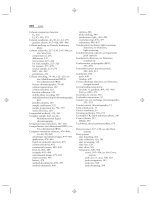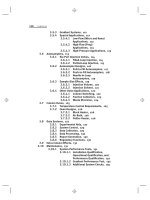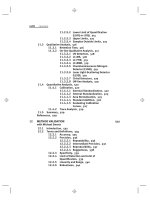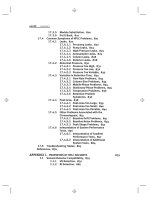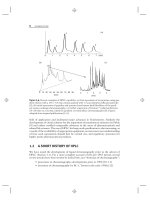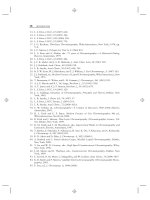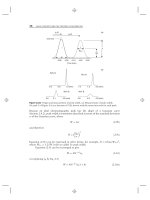Introduction to Modern Liquid Chromatography, Third Edition part 60 pot
Bạn đang xem bản rút gọn của tài liệu. Xem và tải ngay bản đầy đủ của tài liệu tại đây (114.94 KB, 10 trang )
546 METHOD VALIDATION
• an introduction or objective
• method summary including instrument and solution preparation specifics
• validation results in subsections organized by the characteristic studied.
Each subsection should include a brief summary of the applicable protocol,
and the mean, standard deviation, relative standard deviation, acceptance
criteria, and assessment (pass or fail).
• any deviations from the protocol, planned or observed, and the impact
(if any) on the validation
• any amendments to the protocol, with explanations and approvals
• conclusion
A properly designed validation protocol can serve as a template for the validation
report. For example, in the protocol a test can be described and the acceptance
criteria listed. For the validation report, this information is supplemented with
supporting results, a reference to the location and identity of the raw data, and a
pass/fail statement.
12.5 VALIDATION FOR DIFFERENT
PHARMACEUTICAL-METHOD TYPES
The USP recognizes that is it not always necessary to evaluate every analytical
performance characteristic for every test method. The type of method and its
intended use dictate which performance characteristics need to be investigated, as
summarized in Table 12.9 [12]. Both the USP and ICH divide test methods into four
separate categories:
• assays for the quantification of major components or active ingredients
(category 1 methods)
• determination of impurities or degradation products (category 2 methods)
• determination of product performance characteristics (category 3 methods)
• identification tests (category 4 methods)
These test methods and categories generally apply to drug substances and drug
products, as opposed to bioanalytical samples, covered in Section 12.6.
12.5.1 Category 1 Methods
Category 1 tests target the analysis of major components, and include test methods
such as content uniformity and potency assay. The latter methods, while quantitative,
are not usually concerned with low concentrations of analyte, but only with the
amount of the API in the drug product. Because of the simplicity of the separation
(the API must be resolved from all interferences, but any other peaks in the
chromatogram need not be resolved from each other), emphasis is on speed over
resolution. For assays in category 1, LOD and LLOQ evaluations are not necessary
because the major component or active ingredient to be measured is normally present
at high concentrations. However, since quantitative information is desired, all of the
remaining analytical performance characteristics are pertinent.
12.5 VALIDATION FOR DIFFERENT PHARMACEUTICAL-METHOD TYPES 547
Table
12.9
Analytical Performance Characteristics to Measure vs. Type of Method
Analytical Category 1: Category 2: Impurities Category 3: Category 4:
Performance Assays Quantitative Limit Tests Specific Tests Identification
Parameter
Accuracy Yes Yes * * No
Precision Yes Yes No Yes No
Specificity Yes Yes Yes * Yes
LOD No No Yes * No
LLOQ No Yes No * No
Linearity Yes Yes No * No
Range Yes Yes No * No
Robustness Yes Yes No Yes No
Source: Data from [12].
Note: *May be required, depending upon type of test. For example, although dissolution testing falls into
category 3, as a quantitative test, measurements typical of category 1 are used (with some exceptions).
12.5.2 Category 2 Methods
Category 2 tests target the analysis of impurities or degradation products (among
other applications). These assays usually look at much lower analyte concentrations
than category 1 methods, and are divided into two subcategories: quantitative and
limit tests. If quantitative information is desired, a determination of LOD is not
necessary, but the remaining characteristics are required. Methods used in support
of stability studies (referred to as stability-indicating methods) are an example of
a quantitative category 2 test. The situation reverses itself for a limit test. Since
quantification is not required, it is sufficient to measure the LOD and demonstrate
specificity and robustness. For a category 2 limit test, it is only necessary to show
that a compound of interest is either present or not—that is, above or below a
certain concentration. Methods in support of cleaning validation and environmental
EPA methods often fit into this category. Although, as seen in Table 12.9, it is never
necessary to measure both LOD and LLOQ for any given category 2 method, it is
common during validation to evaluate both characteristics (more out of tradition
than necessity).
12.5.3 Category 3 Methods
The characteristics that must be documented for test methods in USP-assay category
3 (specific tests or methods for product performance characteristics) are dependent
on the nature of the test. Dissolution testing is an example of a category 3
method. Since it is a quantitative test optimized for the determination of the
API in a drug product, the validation characteristics evaluated are similar to a
category 1 test for a formulation designed for immediate release. However, for an
extended-release formulation, where it might be necessary to confirm that none of
the active ingredient has been released from the formulation until after a certain
548 METHOD VALIDATION
time point, the characteristics to be investigated would be more like a quantitative
category 2 test that includes LOQ. Because the analytical goals may differ, the
category 3 evaluation characteristics are very dependant on the actual test method,
as indicated in Table 12.9.
12.5.4 Category 4 Methods
Category 4 identification tests are qualitative in nature, so only specificity is required.
Identification can be performed, for example, by comparing the retention time or a
spectrum to that of a known reference standard. Freedom from interferences is all
that is necessary in terms of chromatographic separation.
12.6 BIOANALYTICAL METHODS
Bioanalytical methods refer to test methods for the analysis of drugs and their
metabolites in biological samples, commonly plasma or urine but can include other
animal tissues. Sometimes bioanalytical methods are confused with the analysis of
biomolecules, such as proteins, peptides, and oligonucleotides—the latter separation
techniques are discussed in Chapter 13. Bioanalytical methods are used in clinical
pharmacology, bioavailability, toxicology, bioequivalence, and other studies that
require pharmacokinetic evaluation in support of various drug applications to
regulatory agencies, such as the FDA. In a regulated laboratory, bioanalytical
methods must be validated to demonstrate that they are reliable and reproducible
for their intended use (as for any other analytical method).
Test methods for finished product, raw materials, or active pharmaceutical
ingredients (APIs) each have their own development and validation challenges.
Bioanalytical methods are further complicated by the nature of the sample matrices,
the trace concentrations of drug and metabolites encountered, and (potentially) the
complexity of the required instrumentation.
The sensitivity and selectivity of bioanalytical methods are critical to the success
of preclinical and clinical pharmacology studies. As with any other test method,
the performance characteristics of a bioanalytical method must be demonstrated
(by documented laboratory data) to be reliable and reproducible for its intended
use. Joint industry and regulatory conferences have been held to discuss this
topic (e.g., [13–15]). As a result of the first two conferences in May 2001, the
FDA issued a guidance document for validating bioanalytical methods [16]. In
contrast to performance criteria for drug substance or drug product methods, where
specific performance criteria are listed (e.g., precision and accuracy), bioanalytical
method regulations are listed as ‘‘guidelines.’’ The general interpretation of these
guideline documents is that if test methods are developed that adhere to their
recommendations, there will be less likelihood of a negative regulatory action. In
other words, if the recommendations of the guidelines are not followed, one should
be sure to develop a logical and scientifically supported statement to show that
alternative performance criteria are justified.
Regulated bioanalysis usually involves an HPLC system coupled to a
triple-quadrupole mass spectrometer (LC-MS/MS, Section 4.14). The sensitivity
and selectivity of the LC-MS/MS allows for the quantification of analytes with
12.6 BIOANALYTICAL METHODS 549
acceptable precision and accuracy at concentrations lower than most other HPLC
detectors. Typically short, small-particle columns (e.g., 30–50 × 2.1-mm i.d.
packed with ≤3 μm particles) are used for the fast separations needed for the
large number of samples generated by clinical studies. Either isocratic or gradient
separations with run times <5 min are common. Sample preparation (Chapter 16)
to remove excess protein and other potential interferences can require as much
effort to develop as the HPLC method. Automation of both sample preparation and
analysis is common.
The development and use of a bioanalytical method can be divided into three
parts:
• reference standard preparation
• method development and validation
• application of the validated test method to routine drug analyses
Each of these processes is discussed in following sections.
12.6.1 Reference Standard Preparation
Reference standards are necessary for quantification of the analyte in a biological
matrix. These are used both for calibration (standard) curves and to check method
performance (quality control, QC, samples). Reference standards can be one of
three types: (1) standards whose purity is certified by a recognized organization
(e.g., USP compendial standards), (2) reference standards obtained from another
commercial source (e.g., a company in the business of the sales of general or
specialty chemicals), and (3) custom-synthesized standards. Whenever possible, the
standard should be identical to the analyte, or at least an established chemical
form (e.g., free acid or base, or salt). In each case the purity of the standards must
be demonstrated by appropriate documentation, usually a certificate of analysis.
Supporting documentation such as the lot number, expiration date, certificates of
analysis, and evidence of identity and purity should be kept with other method data
for regulatory inspection. Compounds used for internal standards (often isotopically
labeled drug) must have similar data to support purity.
12.6.2 Bioanalytical Method Development and Validation
The key bioanalytical performance characteristics that must be validated for each
analyte of interest in the matrix include accuracy, precision, selectivity, range,
reproducibility, and stability. In practice, to develop the test method and validate
the method, four areas are investigated:
• selectivity
• accuracy, precision, and recovery
• calibration/standard curve
• stability
From each of these investigations, data are gathered to support the remaining
characteristics.
550 METHOD VALIDATION
12.6.2.1 Selectivity
The selectivity of a test method shows that the analyte can be accurately measured
in the presence of potential interferences from other components in the sample
(including the sample matrix). Interferences can take the form of endogenous matrix
components (proteins, lipids, etc.), metabolites, degradation products, concomitant
medication, or other analytes of interest. The FDA guidelines recommend the analysis
of blank samples of the appropriate biological matrix from at least six different
sources. For example, plasma from each source should be spiked with known
concentrations of analyte at the lower limit of quantification (LOQ or LLOQ) to
show that accurate results can be obtained. Similarly a blank extract of each matrix
should be analyzed to show the absence of interferences. In cases of rare or difficult
to obtain matrix (e.g., plasma from an exotic species or human tissue), the six-matrix
requirement is relaxed.
12.6.2.2 Accuracy, Precision, and Recovery
The accuracy of a bioanalytical method is defined as the closeness of test results to
the true value—as determined by replicate analyses of samples containing known
amounts of the analyte of interest; results are reported as deviations of the mean
from the true value. The FDA guidelines recommend the use of a minimum of
five determinations per concentration, and a minimum of three concentrations over
the expected range (a minimum of 15 separately prepared samples). The guidelines
further recommend that the mean value be within ±15% of the actual value except
at the LLOQ, where ±20% is acceptable.
The precision of a bioanalytical method measures agreement among test
results when the method is applied repeatedly to multiple samplings of a homo-
geneous sample. As in recent ICH guidelines, precision can be further divided
into repeatability (within-run or intra-batch) determinations, and intermediate
(between-run or inter-batch) precision [4]. The FDA guidelines recommend the
use of a minimum of five determinations per concentration, and a minimum of three
concentrations over the expected range. The imprecision measured at each concen-
tration level should not exceed 15% RSD, except for the LLOQ, which should not
exceed 20% RSD. Usually the same data are used to determine both precision and
accuracy.
The assay recovery relates to the extraction efficiency, and this is determined
by a comparison of the response from a sample extracted from the matrix to the
reference standard (with appropriate adjustments for dilution, etc.). The recovery
of the analyte can be <100%, but it must be quantitative. That is, it should be
precise and reproducible. Recovery experiments should be carried out at three con-
centrations (low, medium, and high), with a comparison of the results for extracted
samples vs. unextracted samples (adjusted for dilution). Often it is impractical
to analyze unextracted samples (e.g., injection of unextracted plasma will ruin
most HPLC columns), so creative ways to show recovery may need to be devised.
For example, a liquid–liquid extraction of spiked matrix might be compared to
extraction of a matrix-free aqueous solution; or recovery from a solid-phase extrac-
tion might be determined by calculation of volumetric recovery and comparison
of the response from an extracted sample to a known concentration of reference
standard.
12.6 BIOANALYTICAL METHODS 551
12.6.2.3 Calibration/Standard Curve
A calibration curve (also called a standard curve, or sometimes a ‘‘line’’) illustrates
the relationship between the instrument response and the known concentration of
the analyte, within a given range based on expected values. The simplest model
that describes the proportionality should be used (e.g., a linear fit is preferred over
a quadratic curve-fitting function). Calibration for bioanalytical methods usually
is more complicated than for API assays, which typically have linear calibration
plots that pass through the origin and may only require one calibration standard
concentration. Because a significant amount of sample manipulation takes place in
the typical sample preparation procedure, internal standards (Section 11.4.1.2) are
preferred for most bioanalytical methods. At least four out of six nonzero standards
(67%) should fall within ±15% of the expected concentration (±20% at the
LLOQ). The calibration curve should be generated for every analyte in the sample,
and prepared in the same matrix as the samples by addition of known concentrations
of the analyte to blank matrix. The FDA guidelines suggest that a calibration curve
should be constructed from six to eight nonzero samples that cover the expected
range, including the LLOQ. In addition, noninterference is shown by the analysis of
a blank sample (nonspiked matrix sample processed without internal standard) and
a zero sample (nonspiked matrix processed with internal standard). Two conditions
must be met to determine the LLOQ: (1) analyte response at the LLOQ should be
>
5
times the blank response, and (2) the analyte peak should be identifiable, discreet, and
reproducible with an imprecision of ≤20% and an accuracy of at least 80–120%.
12.6.2.4 Bioanalytical Sample Stability
Stability tests determine that the analyte (and internal standard) does not break
down under typical laboratory conditions, or if degradation occurs, it is known and
can be avoided by appropriate sample handling. Many different factors can affect
bioanalytical sample stability; these include the chemical properties of the drug,
the storage conditions, and the matrix. Studies must be designed to evaluate the
stability of the analyte during sample collection and handling, under both long-term
(at the intended storage temperature) and short-term (bench top, controlled room
temperature) storage conditions, and through any freeze–thaw cycles. The conditions
used for any sample-stability studies should reflect the actual conditions the sample
(including working and stock solutions) may experience during collection, storage,
and routine analysis. Stock solutions should be prepared in an appropriate solvent
at known concentrations. The stability of stock solutions should also be ascertained
at room temperature over at least six hours, and storage-condition stability (e.g.,
in a refrigerator) should be evaluated as well. In addition, since samples commonly
will be left on a bench top or in an autosampler for some period of time, it is also
important to establish the stability of processed samples (e.g., drug and internal
standard extracted from sample matrix) over the anticipated run time for the batch
of samples to be processed. Working standards should be prepared from freshly
made stock solutions of the analyte in the sample matrix. Appropriate standard
operating procedures (SOPs) should be followed for the experimental studies as well
as the poststudy statistical treatment of the data.
The FDA guidelines recommend a minimum protocol that includes freeze and
thaw stability plus short- and long-term temperature stability. For freeze–thaw
552 METHOD VALIDATION
stability, three spiked-matrix sample aliquots at each of the low and high concentra-
tions should be exposed to three freeze–thaw cycles. The samples should be kept at
the storage temperature for 24 hours and then thawed at room temperature (without
heating). When completely thawed, the samples should be refrozen for 12 to 24
hours, then thawed again; this procedure is repeated a third time. Analysis of the
sample then proceeds after completion of the third freeze–thaw cycle.
For short-term temperature stability, three aliquots (at each of the low and high
concentrations) are thawed and kept at room temperature for a time that is equal
to the maximum (e.g., 4–6 hr) the samples will be maintained at room temperature
prior to their analysis.
The storage time for a long-term stability evaluation should bracket the time
between the first sample collection and the analysis of the last sample (often 12
months or more); the sample volume reserved should be sufficient for at least three
separate time points. At each time point, at least three aliquots (at each of the low
and high concentrations) stored under the same conditions as the study samples (e.g.,
−20
◦
Cor−70
◦
C) should be tested. In a long-term stability study the concentration
of the stability samples should be determined using freshly made standards. The
mean of resulting concentrations should be reported relative to the mean of the
results from the first day of the study.
12.6.3 Routine Application of the Bioanalytical Method
Once the bioanalytical method has been validated for routine use, system suitability
and QC samples are used to monitor accuracy and precision, and to determine
whether to accept or reject sample batches. QC samples are prepared separately and
analyzed with unknowns at intervals according to the number of unknown samples
for a sample batch. Duplicate QC samples (prepared from the matrix spiked with
the analyte) at three concentrations (low, near the LLOQ, midrange, and high) are
normally used. The minimum number of QC samples (in multiples of three—low,
midrange, and high concentration) is recommended to be at least 5% of the number
of unknown samples, or six, whichever is greater. For example, if 40 unknowns
are to be analyzed, 40 × 5% = 2, so 6 QCs are run (2 low, 2 midrange, 2 high);
or for 200 samples, 200 × 5% = 10, so 12 QCs are run (4 each, low, midrange,
and high). At least four out of every six QC sample results should be within ±15%
of their respective nominal value. Data representative of typical results obtained by
LC-MS/MS for the analysis of QC samples (at concentrations of 10, 35, 1000, 4400,
and 5000 pg/mL of plasma) are listed in Table 12.10. As mentioned previously,
for acceptable method validation, both the imprecision at each concentration level
(%RSD), and the accuracy (%Bias) must be ≤15% (≤20% at the LLOQ). In
Table 12.10, the maximum %RSD (≤3.9%) and maximum %Bias (≤11.0%) values
at all concentration levels were well within the validation guidelines.
System suitability, sample analysis, acceptance criteria, and guidelines for
repeat analysis or data reintegration should all be performed according to an estab-
lished SOP. The rationale for repeat analyses, data re-integration, and the reporting
of results should be clearly documented. Problems from inconsistent replicate analy-
sis, sample processing errors, equipment failure, or poor chromatography are some
of the issues that can lead to a need to re-analyze samples. In addition recent inter-
pretations [15] of bioanalytical guidelines indicate that a certain number of samples
12.6 BIOANALYTICAL METHODS 553
Table
12.10
Example Bioanalytical LC-MS/MS QC Results
Target
Measured concentration (pg/mL) (pg/mL) n Mean SD %RSD %Bias
QC1 QC2 QC3 QC4 QC5 10.0 10 11.1 0.402 3.6 +11.0
11.8 35.7 1009.8 4670.3 5425.0
35.0 10 34.8 1.37 3.9 −0.6
11.1 37.1 1036.0 4796.4 5334.5
1000.0 10 997.0 35.45 3.6 −0.3
11.4 35.4 1047.2 4684.9 5180.9
4400.0 10 4630.0 160.5 3.5 +5.2
10.4 36.0 975.8 4964.3 5241.6
5000.0 10 5138.3 199.4 3.9 +2.8
10.8 34.6 1047.8 4628.6 5285.6
10.9 34.9 986.5 4564.3 5049.0
10.9 33.6 971.8 4491.9 5009.2
10.8 32.6 960.4 4404.1 4883.7
11.3 33.2 956.7 4539.5 5170.8
11.4 34.4 977.8 4558.6 4802.7
be reanalyzed on a routine basis to ensure method performance (sometimes referred
to as ‘‘incurred sample reproducibility’’).
12.6.4 Bioanalytical Method Documentation
As discussed previously in Section 12.4, good record keeping and documented
SOPs are an essential part of any validated test method. Once the validity of a
bioanalytical method is established and verified by laboratory studies, pertinent
information is provided in an assay validation report. Data generated during method
development and QC should be available for audit and inspection. Documentation
for submission to the FDA should include (1) summary information, (2) method
development and validation reports, (3) reports of the application of the test method
to routine sample analysis, and (4) other miscellaneous information (e.g., SOPs,
abbreviations, and references).
The summary information should include a tabular listing of all reports,
protocols, and codes. The documentation for method development and validation
should include a detailed operational description of the experimental procedures and
studies, purity and identity evidence, method validation specifics (results of studies
to determine accuracy, precision, recovery, etc.), and any protocol deviations with
justifications. Documentation of the application of the test method to routine sample
analysis is usually quite extensive. It should include:
• summary tables describing sample processing and storage
• detailed summary tables of analytical runs of pre-clinical or clinical samples
• calibration curve data
• QC sample summary data including raw data, trend analysis, and summary
statistics
554 METHOD VALIDATION
• example chromatograms (unknowns, standards, QC samples) for up to 20%
of the subjects
• reasons and justification for any missing samples or any deviations from
written protocols or SOPs
• documentation for any repeat analyses, or re-integrated data
12.7 ANALYTICAL METHOD TRANSFER (AMT)
In a regulated environment, it is rare for the laboratory that develops and val-
idates a test method to perform all of the routine sample testing. Instead, once
developed and validated (in the originating, or ‘‘sending’’ laboratory), test methods
are commonly transferred to another laboratory (the ‘‘receiving’’ laboratory) for
implementation. However, the receiving laboratory must still be able to get the
same results, within experimental error, as the sending laboratory. The objective
of a formal method-transfer process is to ensure that the receiving laboratory is
well-trained, qualified to run the test method in question, and able to obtain the
same results (within experimental error) as the sending laboratory. The development
and validation of robust test methods and a strict adherence to well-documented
SOPs are the best ways to ensure the ultimate success of the method.
The process that provides documented evidence that the analytical method
works as well in the receiving laboratory as in the sending laboratory, is called
analytical method transfer (AMT). The topic of AMT has been addressed by the
American Association of Pharmaceutical Scientist (AAPS, in collaboration with
the FDA and EU regulatory authorities), the Pharmaceutical Research and Manu-
facturers of America (PhRMA), and the International Society for Pharmaceutical
Engineering (ISPE) [17–18]. The PhRMA activities resulted in what is referred to as
an Acceptable Analytical Practice (AAP) document that serves as a suitable first-step
guidance document for AMT [19].
In essence, the AMT process qualifies a laboratory to use a test method;
regulators will want documented proof that this process was completed successfully.
Only when both of these processes (qualification and documentation) are complete
can the receiving laboratory obtain cGMP ‘‘reportable data’’ from their laboratory
results. AMT specifically applies to drug product and drug substance methods,
but the same principles can apply to bioanalytical methods (Section 12.6). A
typical example is when AMT takes place between a research group that develops
the test method and a quality-control group responsible for the release of the
finished product. Any time information moves from one group to another (e.g.,
from a pharmaceutical company to a contract analytical laboratory), proper AMT
should be observed. Both the sending and the receiving laboratory have certain
responsibilities in the AMT process; these are listed in Table 12.11.
Before initiating AMT, several pre-transfer activities should take place to
minimize unexpected problems in method transfer. If not previously involved with
the test method, the receiving laboratory should have an opportunity to review the
method prior to the transfer, and to carry out the method so as to identify any
potential issues that may need to be resolved prior to finalization of the transfer
protocol. The sending laboratory should provide the receiving laboratory with all
12.7 ANALYTICAL METHOD TRANSFER (AMT) 555
Table
12.11
Analytical Method Transfer: Sending and Receiving Laboratory Responsibilities
Sending Laboratory Responsibilities Receiving Laboratory Provides
Create the transfer protocol Qualified instrumentation
Execute training Personnel
Assist in analysis Systems
Acceptance criteria Protocol execution
Final report (with receiving laboratory) Final report (with sending laboratory)
of the validation results, including robustness study results, as well as documented
training.
12.7.1 Analytical Method-Transfer Options
The foundation of a successful AMT is a properly developed and validated method.
A good robustness study will also help facilitate method transfer. A well-designed
AMT process requires that a sufficient number of samples should be run to support
a statistical assessment of method performance, because a single test is no indication
of how well a test method will perform over time. A formal AMT is not always
necessary, however. In-process tests or research methods do not require a formal
transfer; a system suitability test is employed as the basis for the transfer. In all cases
sound scientific judgment should guide the AMT requirements.
Several different techniques can be used for AMT. These include:
• comparative testing
• complete or partial method validation or revalidation
• co-validation between the two laboratories
• omission of a formal transfer, sometimes called a transfer waiver
The choice of which option to use depends on the stage of development in which the
test method is to be used (early or late stage), the type of method (e.g., compendial
vs. noncompendial; simple or complex), and the experience and capabilities of the
laboratory personnel.
12.7.1.1 Comparative Testing
The most common AMT option used is to compare test data from two (or
more) laboratories. This is accomplished when two or more laboratories per-
form a pre-approved protocol that details the criteria used to determine whether the
receiving laboratory is qualified to use the test method being transferred. The data
resulting from the joint exercise are compared to a set of predetermined acceptance
criteria. For example, a blinded set of samples and blanks at known concentrations
might be provided to both the sending and receiving laboratories; the individual
laboratory results would then be compared to the true values to qualify the receiving
laboratory. Comparative testing can also be used in other postapproval situations
